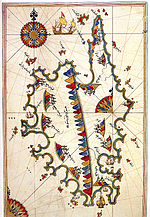

| History of Corsica |
|---|
 |
|
|
The prehistory of Corsica is analogous to the prehistories of the other islands in the Mediterranean Sea, such as Sicily, Sardinia, Malta and Cyprus, which could only be accessed by boat and featured cultures that were to some degree insular; that is, modified from the traditional Paleolithic, Mesolithic, Neolithic and Chalcolithic of European prehistoric cultures. The islands of the Aegean Sea and Crete early developed Bronze Age civilizations and are accordingly usually treated under those categories. Stone Age Crete however shares some of the features of the prehistoric Mediterranean islands.
The possible presence of Upper Paleolithic people on Corsica during the last glacial period is a topic of interest to professional and amateur prehistorians alike. Currently only one possible site of this period is known. For most of the Paleolithic, Corsica, Sardinia, and all the islands between them were physically continuous with the Italian peninsula, although they have been islands at various times both before and after in geologic history.
The insular prehistory of Corsica begins with the Mesolithic (Pre-Neolithic) when people from prehistoric Sardinia crossed the Strait of Bonifacio to hunt from rock shelters in Corsica at approximately 9000 BC. It ends with colonization by the Ancient Greeks at Aléria in 566 BC, the Iron Age. Corsica, or Kyrnos, is not mentioned before then. Thus the history of Corsica begins in 566 BC.
